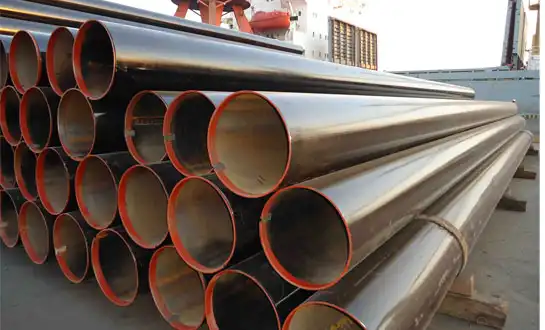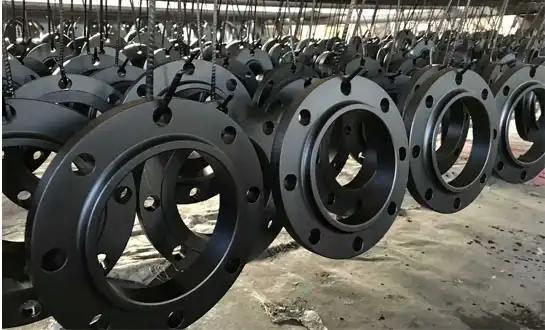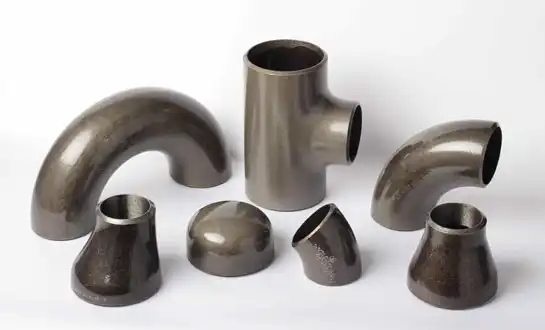Welding Duplex Butt Weld Fittings: Tips to Avoid Common Failures
Welding duplex butt weld fittings requires meticulous technical expertise and strict procedural standards that distinguish successful installations from problematic systems. Duplex steel pipe fittings represent sophisticated solutions combining strength with corrosion resistance, yet performance depends entirely on proper welding execution. Common failures stem from inadequate heat input control, improper shielding gas management, or insufficient interpass temperature monitoring. Understanding these failure mechanisms and implementing preventive measures ensures duplex steel pipe fittings deliver decades of reliable service across demanding industrial environments. This guide explores critical welding challenges specific to duplex steel pipe fittings and provides practical strategies installation teams can implement immediately to eliminate costly rework and premature failures.
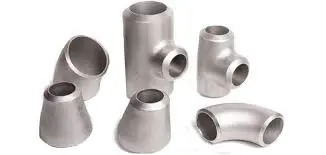
Pre-Welding Preparation and Material Qualification
Surface Cleanliness and Contamination Prevention
Achieving pristine weld quality in duplex steel pipe fittings begins with thorough surface preparation that removes contaminants capable of compromising joint integrity. Oil, grease, paint, and moisture can become entrapped within the molten pool during the welding of duplex steel pipe fittings, creating porosity and reducing mechanical strength. Mechanical cleaning using stainless steel wire brushes dedicated exclusively to duplex steel pipe fittings ensures foreign materials remain absent from joint surfaces. Solvent cleaning with acetone removes invisible oxide films and organic residues that weaken duplex steel pipe fittings' weld metal. Even microscopic contamination can initiate failure mechanisms under cyclic loading or corrosive exposure. Dry-cleaned duplex steel pipe fittings surfaces completely before welding, preventing moisture absorption that causes hydrogen-induced cracking in high-strength materials.
Proper Joint Fit-Up and Gap Control
Correct geometric alignment establishes the foundation for successful duplex steel pipe fittings welding outcomes. The root gap should remain between 1.5 to 3.0 millimeters, depending on wall thickness and procedure requirements. Excessive gaps force welders to use prolonged arc exposure and elevated heat input, creating oversized heat-affected zones susceptible to intermetallic phase precipitation in duplex steel pipe fittings. Insufficient gaps trap shielding gas and prevent complete root weld penetration, leaving internal voids that propagate into cracks. Pipe ends must be cut squarely using mechanical equipment rather than manual methods. Secure duplex steel pipe fittings alignment using specialized clamps, maintaining consistent positioning throughout welding and preventing distortion that compromises geometry.
Welder Qualification and Procedural Compliance
Producing sound welds in duplex steel pipe fittings demands significantly higher skill levels than conventional carbon steel alternatives. Welders must demonstrate qualification through rigorous testing on duplex steel pipe fittings under actual production conditions. Establish detailed written welding procedures specific to duplex steel pipe fittings that specify equipment parameters, heat input ranges, and cooling protocols. ASME B31.3 and B31.1 standards provide guidance for developing comprehensive procedures applicable to duplex steel pipe fittings installations. Require welders to maintain detailed process records documenting heat input values, interpass temperatures, and ambient conditions for every duplex steel pipe fittings assembly, enabling rapid investigation if issues emerge.
Thermal Management and Microstructural Control
Heat Input Optimization and Temperature Prevention
Careful heat input control during duplex steel pipe fittings welding prevents deleterious intermetallic phase formation that embrittle the material. Maintain heat input between 0.5 and 2.5 kilojoules per millimeter for standard duplex steel pipe fittings grades. Excessive heat promotes sigma and chi phase precipitation in the 700 to 900 degrees Celsius range. Modern welding equipment enables real-time monitoring and adjustment of amperage and voltage to maintain heat input within narrow windows. Limit welding speed appropriately when working with duplex steel pipe fittings; rapid travel reduces heat input excessively, causing incomplete penetration defects. Establish intermediate passes that reduce accumulated thermal energy between successive layers, preventing excessive temperature buildup, threatening duplex steel pipe fittings.
Interpass Temperature Control and Cooling Protocols
The temperature at which subsequent passes are deposited profoundly influences microstructural development and performance of duplex steel pipe fittings. Allow cooling between passes below 250 degrees Fahrenheit before commencing subsequent welding on duplex steel pipe fittings to prevent excessive heat accumulation. Measure interpass temperatures using calibrated crayons or infrared thermometers dedicated to duplex steel pipe fittings monitoring, documenting values for traceability. Higher-grade duplex compositions demonstrate increased sensitivity to cumulative thermal exposure, necessitating tighter control for super duplex steel pipe fittings. Water spray or air cooling between passes facilitates temperature management without introducing hydrogen into duplex steel pipe fittings' weld metal. Restart subsequent passes only after confirming temperatures remain within specified ranges.
Backing Gas Application and Root Bead Integrity
The root pass establishes the foundation for multipass duplex steel pipe fittings welds, and requires special attention to shielding gas coverage. Apply backing gas on the root side of duplex steel pipe fittings joints to prevent atmospheric oxygen from entering the weld pool. Nitrogen-enriched shielding gas containing approximately 2 percent nitrogen prevents nitrogen loss during the welding of duplex steel pipe fittings while maintaining pitting resistance. Root beads in duplex steel pipe fittings require careful inspection before depositing subsequent passes; grind away surface irregularities. Position root beads at slightly higher heat input than recommended for subsequent passes when welding duplex steel pipe fittings, ensuring adequate penetration that fuses completely through joint thickness.
Quality Assurance and Defect Prevention Protocols
Penetration Achievement and Lack of Fusion Elimination
Incomplete weld penetration represents a catastrophic failure mode in duplex steel pipe fittings installations, creating internal discontinuities that concentrate stress. Achieve full penetration through the entire joint depth by maintaining adequate amperage and proper travel speed when welding duplex steel pipe fittings. Verify root pass penetration by performing radiographic or ultrasonic inspection on representative samples from duplex steel pipe fittings production runs. Lack of fusion between weld layers indicates inadequate heat input or improper torch angle on duplex steel pipe fittings. Establish mandatory cleaning procedures between passes using stainless steel wire brushes to remove slag. Reject any duplex steel pipe fittings with welds showing underbead defects; these internal discontinuities compromise structural reliability regardless of external appearance.
Porosity Control and Shielding Gas Management
Gas bubbles entrapped during solidification create porosity defects, reducing mechanical strength and initiating fatigue cracks in duplex steel pipe fittings. Prevent porosity in duplex steel pipe fittings by maintaining consistent shielding gas flow rates and confirming gas purity before commencing operations. Inspect gas cylinders for damage that permits moisture entry; contamination produces hydrogen-containing porosity in duplex steel pipe fittings. Clean welding contact tips and nozzles regularly to ensure unobstructed gas delivery. Reduce travel speed and maintain perpendicular torch angles relative to duplex steel pipe fittings surfaces, allowing adequate time for gas bubbles to escape. Surface porosity indicates systemic problems requiring corrective action before proceeding.
Inspection Requirements and Documentation Standards
Establish comprehensive inspection protocols applicable to duplex steel pipe fittings that verify weld quality meets industry standards. Perform visual inspection within hours of completion, documenting bead appearance and observable defects. Conduct magnetic particle testing on duplex steel pipe fittings to detect subsurface discontinuities, particularly valuable for identifying hydrogen-induced cracking. Perform hydrostatic pressure testing on finished duplex steel pipe fittings assemblies at pressures exceeding service requirements. Maintain detailed records of testing results, welder identifications, and procedure compliance for each duplex steel pipe fittings installation, enabling rapid investigation if failures emerge.
Conclusion
Mastering duplex steel pipe fittings welding requires a comprehensive understanding of thermal management and rigorous procedural discipline, eliminating common failure mechanisms. Proper surface preparation, heat input control, and quality assurance transform duplex steel pipe fittings into dependable solutions delivering exceptional performance. At HEBEI RAYOUNG PIPELINE TECHNOLOGY CO., LTD., we supply high-quality duplex steel pipe fittings engineered to ASME, GOST-R, and ISO 9001:2015 standards, ensuring consistent quality across critical applications.
FAQ
1. What are the most common welding defects in duplex steel pipe fittings?
Porosity, incomplete penetration, and lack of fusion represent primary defects in duplex steel pipe fittings welding, typically from inadequate heat input or gas contamination. Intermetallic phase precipitation degrades corrosion resistance and toughness, defining duplex steel pipe fittings. Prevention requires strict procedure adherence developed specifically for duplex steel pipe fittings materials. Comprehensive inspection, including radiography and magnetic particle testing, detects defects before duplex steel pipe fittings enter service, ensuring field reliability.
2. Why is heat input control critical for duplex steel pipe fittings?
Excessive heat during duplex steel pipe fittings welding promotes sigma and chi phase formation, reducing toughness and corrosion resistance substantially. Controlled heat input between 0.5 and 2.5 kilojoules per millimeter maintains beneficial microstructure in duplex steel pipe fittings. Inadequate heat causes incomplete penetration, compromising joint strength. Modern monitoring enables maintaining duplex steel pipe fittings heat input within narrow specifications, dramatically improving quality and reliability.
3. How does interpass temperature management affect duplex steel pipe fittings' reliability?
Cooling between passes below 250 degrees Fahrenheit prevents heat accumulation, accelerating intermetallic phase formation in duplex steel pipe fittings. Higher-grade duplex materials demonstrate increased thermal sensitivity, demanding tighter control for super duplex steel pipe fittings. Inadequate cooling promotes brittle microstructures in duplex steel pipe fittings, initiating unexpected cracking. Strict temperature monitoring ensures consistent microstructural properties throughout service.
4. What inspection methods verify duplex steel pipe fittings' weld quality?
Visual inspection, radiographic testing, magnetic particle examination, and hydrostatic pressure testing provide a comprehensive evaluation of duplex steel pipe fittings. Radiography detects internal porosity compromising duplex steel pipe fittings. Magnetic particle testing reveals subsurface discontinuities specific to high-strength duplex steel pipe fitting materials. Hydrostatic testing confirms that finished duplex steel pipe fittings assemblies maintain integrity under extreme conditions.
HEBEI RAYOUNG PIPELINE: Leading Duplex Steel Pipe Fittings Manufacturers and Suppliers
Selecting a reliable supplier for duplex steel pipe fittings directly determines whether infrastructure projects achieve superior performance or encounter costly failures. HEBEI RAYOUNG PIPELINE TECHNOLOGY CO., LTD. stands as a dependable duplex steel pipe fittings manufacturer, consistently delivering products manufactured to GOST-R, SGS, and ISO 9001:2015 standards. Our expertise ensures every duplex steel pipe fitting component meets rigorous specifications demanded by critical infrastructure.
We recognize that excellent infrastructure requires dependable materials combined with manufacturing excellence. As leading pipes and fittings manufacturers, we supply comprehensive duplex steel pipe fittings solutions, including buttweld steel elbows, tees, reducers, and flanges, ensuring secure connection points. Our diverse industrial pipe fittings portfolio addresses all design requirements from straight lines to complex angles. Each duplex steel pipe fitting assembly benefits from advanced manufacturing, rigorous verification, and supply chain transparency, distinguishing RAYOUNG competitively.
Whether managing water systems, gas lines, or critical processes, our duplex steel pipe fittings deliver uncompromised performance and long-term durability. Experience why leading engineering firms worldwide trust RAYOUNG for mission-critical duplex steel pipe fittings installations. Contact our technical team today to discuss your requirements and discover how our expertise transforms infrastructure vision into reality. Reach out at info@hb-steel.com to explore customized duplex steel pipe fittings solutions for your applications.
References
1. American Society of Mechanical Engineers. (2023). "ASME B31.3 Process Piping: Section on Duplex Stainless Steel Welding Requirements." ASME Standards Publications, New York, NY.
2. American Welding Society. (2022). "AWS D1.1/D1.1M: Structural Welding Code – Steel with Duplex Steel Pipe Fittings Applications." Miami, FL.
3. Outokumpu Stainless Oy. (2023). "How to Weld Type 2205 Duplex Stainless Steel: Technical Guidelines for Butt Weld Fittings." Espoo, Finland.
4. ASTM International. (2023). "ASTM A815/A815M Standard Specification for Wrought Duplex Stainless Steel Piping Fittings and Related Components." West Conshohocken, PA.
5. Ward Vessel and Exchanger Corporation. (2022). "Best Practice for Welding Duplex Stainless Steels: Procedures Minimizing Common Failures." Technical Publication Series, United States.
6. International Organization for Standardization. (2023). "ISO 9001:2015 Quality Management Systems: Requirements for Duplex Steel Pipe Fittings Manufacturers and Welding Processes." Geneva, Switzerland.

Need a quote? Want to see samples? Just say hello. We’re friendly. We’re fast. And we’re ready when you are.
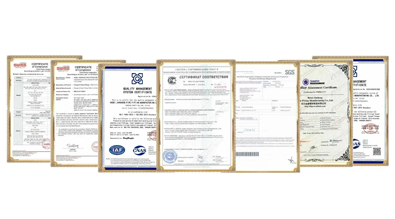
Welcome to RAYOUNG – Strong Pipes, Stronger Promise
